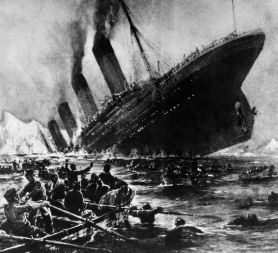Titanic: wrong turn blamed for sinking
Almost 100 years after the sinking of the Titanic, a new theory suggests a wrong turn may have led to the disaster. But relatives tell Channel 4 News there is still no consensus.
The latest version – by the novelist Louise Patten – suggests that a breakdown in communications caused the steersman to turn the ship the wrong way in the face of the iceberg.
And, despite the collision, she says the captain was ordered to keep on going, rather than wait for a rescue ship.
Lady Patten, whose grandfather was Second Officer on board, said she was revealing the secret for the first time to expose what really lay behind the tragedy, which left more than a thousand people dead on the Titanic’s maiden voyage in 1912.
Although her grandfather, Charles Lightoller, died before she was born, her grandmother told her the story of what happened.
‘Simple mistake’
He maintained that the disaster began with a simple mistake: at the time, sailing ships and steam ships used different steering systems, the old fashioned tiller orders, and the new rudder orders associated with the more modern steam ships.
My mother insisted that everything remained strictly inside the family: a hero’s reputation was at stake. Lady Patten
That meant the steersman, Quartermaster Robert Hichins, panicked after failing to understand an order to steer away from the danger.
Lady Patten said the two systems were complete opposites: “So a command to turn ‘hard a-starboard’ meant turn the wheel right under one system, and left under another.”
By the time the mistake was clear, nothing could be done to stop the Titanic ploughing straight into the iceberg.
But according to her grandfather’s account, a series of decisions by senior officers compounded the disaster. He said the chairman of the White Star line pressured the Titanic’s captain to keep sailing, in order to protect the company’s reputation.

Family secret
Lady Patten claims if he had been advised to stop there might have been time for help to arrive before the Titanic finally sank.
But she told the Guardian her grandfather had chosen not to tell his story to the authorities at the time. “He thought he had a duty to protect his employers”, she said.
“He never doubted for one moment that it was the right thing to do.”
Her mother was determined to keep the secret: “My mother insisted that everything remained strictly inside the family: a hero’s reputation was at stake.”
However Lady Patten decided the tale was perfect material for her novel, Good as Gold – the story of a rich banker branded a coward after escaping the sinking ship.
Alternative theories
However Sally Neillson, the great granddaughter of Robert Hichins, has also been re-examining events for her upcoming biography of the quartermaster.
These were experienced men, a very experienced crew. I completely disagree with this theory. Sally Neillson
She says there “is no way on earth” the accident could be blamed on the steermaster.
Ms Neillson told Channel 4 News that the crew was recruited in Southampton during coal strikes. Competition for the six quartermaster roles was tough and they were chosen carefully.
“Hichins had 10 years experience, seven of those as a quartermaster. He sailed the Titanic for four days before the accident, during which he did shifts of four hours on, four hours off. He would have steered the vessel during these times, so been familiar with the systems. He knew ships.
“These were experienced men, a very experienced crew. I completely disagree with this theory.”
Ms Niellson claims to have new theories of her own which will appear in her book – Hard a-starboard – due to be published before the centenary anniversary of 2012.
Other Titanic experts said claims about the steersman’s orders have been made before, and that Lady Patten’s is one theory among many competing for attention in the run up to the centenary of the disaster.